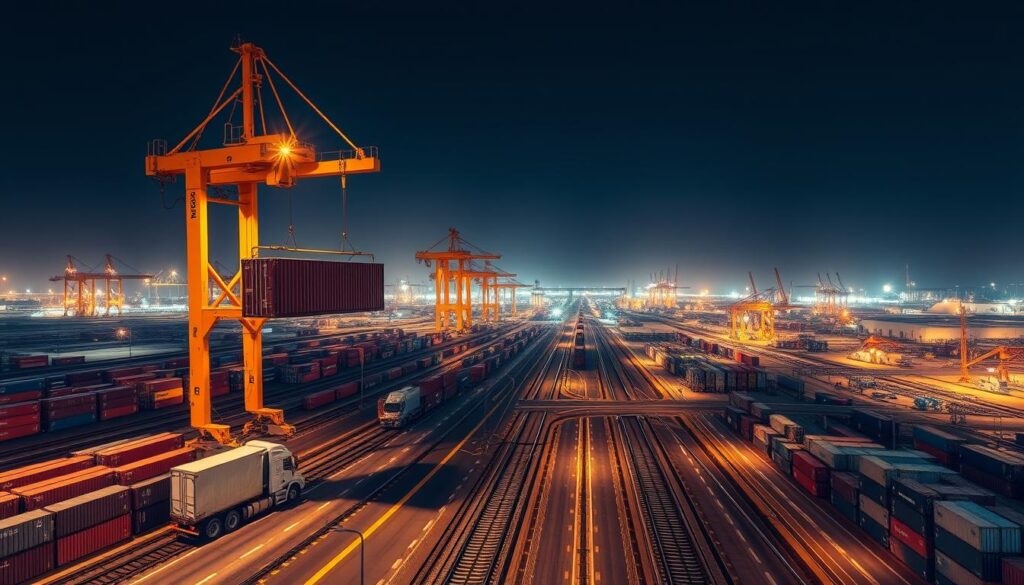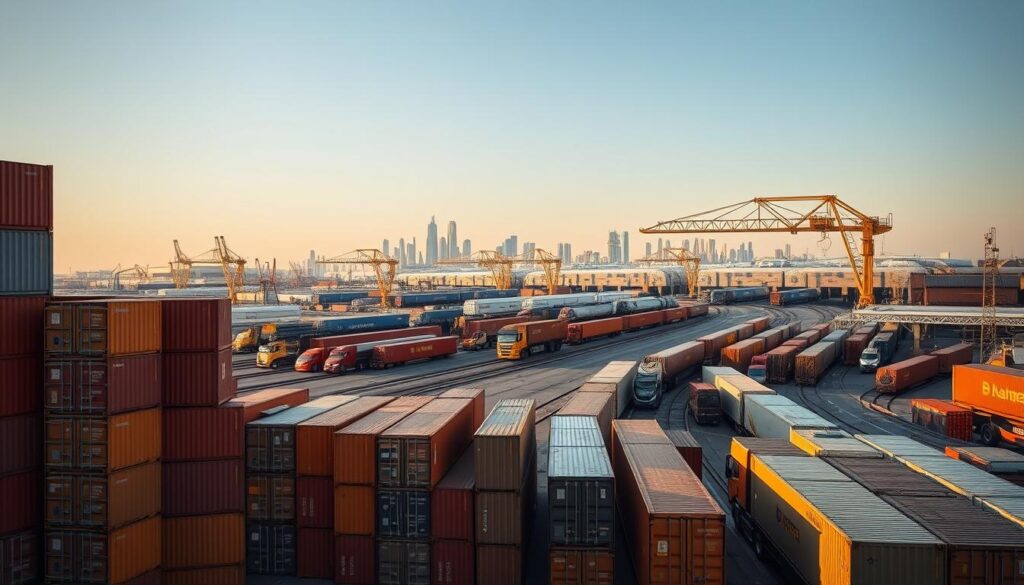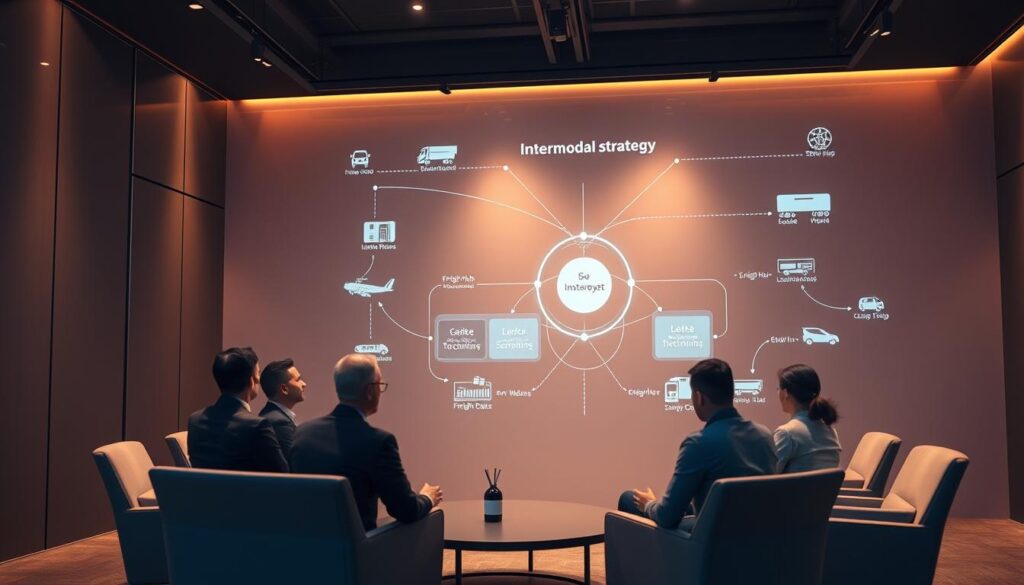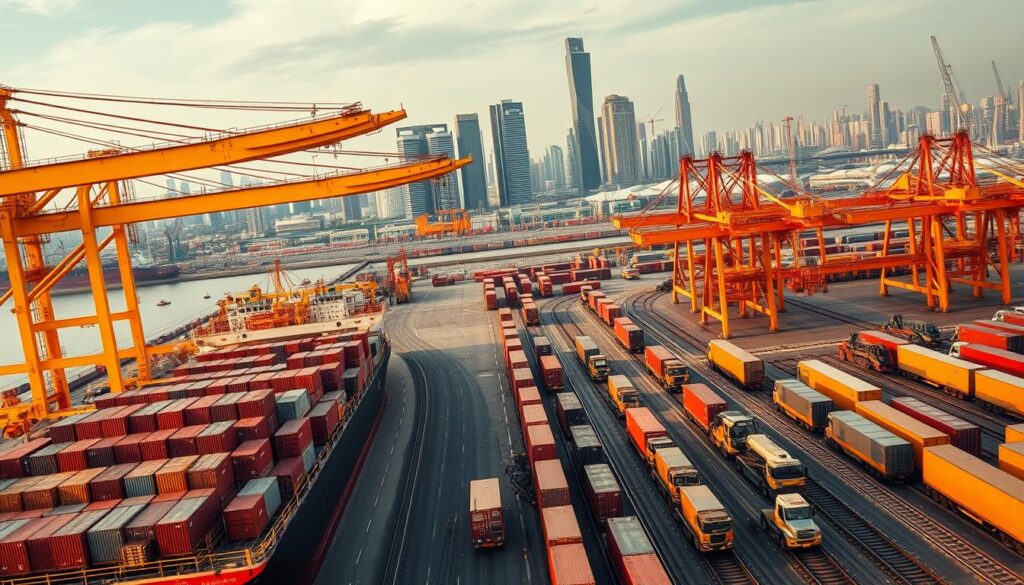Can the logistics industry overcome its inefficiencies and achieve a more streamlined supply chain? The answer lies in intermodal transport engineering, a game-changer in the world of logistics.
As the demand for faster and more reliable logistics optimization continues to grow, companies are turning to innovative solutions to stay ahead of the curve. Intermodal transportation has emerged as a vital component of modern logistics, enabling businesses to move goods efficiently across vast distances.
By leveraging multiple modes of transport, companies can achieve supply chain efficiency, reduce costs, and improve overall productivity. As the logistics landscape continues to evolve, it’s clear that intermodal transport engineering will play a critical role in shaping its future.
Key Takeaways
- Efficient supply chain management is crucial for businesses to stay competitive.
- Intermodal transportation offers a range of benefits, including cost savings and reduced carbon emissions.
- Logistics optimization is key to achieving a more streamlined supply chain.
- Companies can achieve supply chain efficiency by leveraging multiple modes of transport.
- The future of logistics will be shaped by intermodal transport engineering.
What is Intermodal Transport Engineering?
Intermodal transport engineering involves the integration of multiple transportation modes to facilitate the efficient movement of goods. This approach has gained significant attention in the logistics industry due to its potential to enhance supply chain efficiency.
By combining different modes of transport, such as rail, road, and sea, intermodal transport engineering minimizes the handling of goods during transit. This reduction in handling not only decreases the risk of stock losses but also enhances overall efficiency by streamlining the freight movement analysis process.
Definition and Key Concepts
At its core, intermodal transport engineering is about optimizing the movement of goods through multiple transportation modes. This involves the use of intermodal containers that can be easily transferred between different modes of transport, such as from a ship to a train or truck, without the need to reload the cargo.
The key concepts include the integration of various transport modes, the use of standardized containers, and the implementation of efficient logistics systems. For instance, the use of freight rail intermodal services has become increasingly popular as it offers a cost-effective and environmentally friendly way to move goods over long distances.
| Transport Mode | Key Characteristics | Advantages |
|---|---|---|
| Rail | High capacity, long-distance | Cost-effective, environmentally friendly |
| Road | Flexible, door-to-door service | Convenient for last-mile delivery |
| Sea | High volume, international trade | Ideal for global supply chains |
Importance in Today’s Supply Chain
In today’s complex supply chain landscape, intermodal transport engineering plays a crucial role in ensuring the smooth and efficient movement of goods. By leveraging multiple transport modes, businesses can reduce transit times, lower costs, and improve their overall supply chain efficiency.
The importance of intermodal transport engineering is further underscored by its ability to adapt to changing global trade patterns and consumer demands. As the logistics industry continues to evolve, the integration of advanced technologies and innovative logistics solutions will be key to unlocking the full potential of intermodal transport engineering.
The Evolution of Intermodal Transport
Intermodal transport engineering has evolved substantially, becoming a cornerstone of modern transportation infrastructure planning. This evolution is a response to the growing demand for efficient and cost-effective logistics solutions.
“The future of logistics is intermodal,” as noted by industry experts, highlighting the significance of this transport method in today’s supply chain. The shift towards intermodal transport is driven by its ability to provide seamless, door-to-door delivery services, leveraging the strengths of different transport modes.
Historical Background
The concept of intermodal transport is not new; it has its roots in the early 20th century when railroads began to integrate with other transport modes. However, it wasn’t until the latter part of the century that intermodal transport started to gain prominence, driven by advances in containerization and transportation technology.

The historical development of intermodal transport has been marked by significant milestones, including the introduction of standardized containers, which greatly simplified the transfer of goods between different modes of transport.
Milestones in Intermodal Development
Several key milestones have shaped the evolution of intermodal transport:
- The establishment of the first intermodal terminals, which facilitated the efficient transfer of containers between ships, trains, and trucks.
- Advances in information technology, enabling real-time tracking and monitoring of shipments.
- The development of new equipment and containers designed to optimize intermodal transport operations.
These advancements have contributed to the growth of multimodal freight transport, making it a vital component of global trade.
As we look to the future, it’s clear that intermodal transport will continue to play a crucial role in shaping the logistics landscape, driven by ongoing innovations in intermodal transport engineering and transportation infrastructure planning.
Key Components of Intermodal Transport
Understanding the key components of intermodal transport is crucial for optimizing logistics operations. Intermodal transport combines different modes of transport, including lorries, trains, and ships, utilizing standardized containers to facilitate the transfer of goods.
Modes of Transport
Intermodal transport relies on the integration of various transport modes. Road transport provides the initial leg of the journey, connecting businesses to rail terminals or seaports. Rail transport is often used for the long-haul segment due to its efficiency and cost-effectiveness. Finally, maritime transport enables the global movement of goods across oceans.
The flexibility of intermodal transport allows for adjustments based on the specific needs of the shipment, such as choosing between faster but more expensive road transport or more economical but slower sea transport.
Infrastructure Requirements
Effective intermodal transport requires robust infrastructure, including terminals, roads, and rail networks. Intermodal terminals are critical hubs where cargo is transferred between different modes of transport. These terminals must be designed to handle large volumes of cargo efficiently, with features such as advanced container handling equipment and streamlined logistics processes.
Equipment and Containers
The use of standardized containers is a cornerstone of intermodal transport, allowing for easy transfer between different modes of transport without the need to reload cargo. These containers come in various sizes, with the most common being 20-foot and 40-foot containers.
The equipment used in intermodal transport includes cranes, forklifts, and container handlers, which are essential for loading and unloading containers from trucks, trains, and ships.
| Mode of Transport | Primary Use | Key Infrastructure |
|---|---|---|
| Road | Initial and final leg, regional transport | Highways, roads, logistics centers |
| Rail | Long-haul, bulk transport | Rail networks, rail terminals |
| Sea | Global, long-distance transport | Seaports, container terminals |
Benefits of Intermodal Transport Engineering
Intermodal transport engineering is transforming the way goods are moved, offering cost efficiency, time savings, and reduced environmental impact. By integrating different modes of transport, businesses can leverage the strengths of each to create a more efficient logistics system.
Cost Efficiency
One of the primary benefits of intermodal transport engineering is cost efficiency. By optimizing routes and modes of transport, companies can significantly reduce their transportation costs. For instance, a study by the Container News found that intermodal transport can reduce costs by up to 20% compared to traditional unimodal transport methods.
| Transport Mode | Cost per Ton-Mile | Efficiency Rating |
|---|---|---|
| Rail | $0.05 | High |
| Road | $0.10 | Medium |
| Sea | $0.02 | High |
Time Savings
Intermodal transport engineering also offers significant time savings. By optimizing logistics networks and utilizing the fastest modes of transport for different legs of a journey, companies can reduce transit times. According to World Civil Society, intermodal transport can reduce transit times by up to 30%.
Efficient logistics planning is crucial for achieving these time savings. It involves analyzing different transport modes and routes to determine the fastest and most reliable options.
Environmental Impact
The environmental impact of intermodal transport engineering is another significant benefit. By shifting to more sustainable transportation solutions, such as rail and sea transport, companies can reduce their carbon footprint. Intermodal transport can lead to a significant reduction in greenhouse gas emissions, making it a more sustainable option for businesses.

Overall, intermodal transport engineering offers a compelling solution for businesses looking to improve their logistics operations while reducing their environmental impact.
Challenges in Intermodal Transport
Effective intermodal transport requires overcoming several key challenges, including coordination issues and regulatory hurdles. As the logistics industry continues to evolve, understanding and addressing these challenges is crucial for the success of intermodal transport operations.
Coordination Issues
One of the primary challenges in intermodal transport is the coordination among different stakeholders, including carriers, terminal operators, and customs authorities. Efficient coordination is essential to ensure smooth transitions between different modes of transport.
A notable example of coordination challenges can be seen in the delays often experienced at terminals due to inadequate planning and communication. According to a report, improving coordination can reduce transit times by up to 20%. Transportation engineers play a vital role in optimizing these processes.
“The ability to coordinate and manage the flow of goods across different transport modes is critical in intermodal transport.”
Regulatory Hurdles
Regulatory hurdles pose another significant challenge. Different countries and regions have varying regulations regarding safety, security, and environmental impact, which can complicate intermodal transport operations.
| Region | Regulatory Focus | Impact on Intermodal Transport |
|---|---|---|
| Europe | Emissions Reduction | Stricter emissions controls |
| North America | Safety Standards | Enhanced safety protocols |
| Asia | Customs Regulations | Varied customs procedures |
Technology Integration
The integration of technology is both a challenge and an opportunity for intermodal transport. Technologies such as real-time tracking and data analytics can significantly enhance operational efficiency.
However, the adoption of these technologies requires substantial investment and can be hampered by compatibility issues between different systems.
In conclusion, addressing the challenges in intermodal transport requires a multifaceted approach that includes improving coordination, navigating regulatory hurdles, and leveraging technology. By understanding and tackling these challenges, the logistics industry can enhance the efficiency and effectiveness of intermodal transport operations.
The Role of Technology in Intermodal Transport
As the logistics industry evolves, technology plays a crucial role in shaping the future of intermodal transport. The integration of advanced technologies is enhancing the efficiency, reliability, and visibility of intermodal transport operations.
“Technology is the backbone of modern logistics,” says an industry expert. “It enables real-time tracking, automates complex processes, and provides valuable insights through data management.”
Tracking and Visibility Solutions
One of the significant advancements in intermodal transport is the implementation of tracking and visibility solutions. These technologies allow for real-time monitoring of shipments, providing stakeholders with accurate and up-to-date information.
Benefits of Tracking and Visibility:
- Improved supply chain transparency
- Enhanced customer satisfaction through timely updates
- Reduced risk of loss or theft

Automation and Robotics
Automation and robotics are transforming intermodal transport by streamlining processes and reducing manual labor. Automated systems can handle tasks such as sorting, loading, and unloading, thereby increasing efficiency and reducing costs.
For instance, robotic process automation (RPA) is being used to automate repetitive tasks, freeing up human resources for more complex and value-added activities.
Data Management Systems
Effective data management is critical in intermodal transport, as it enables the analysis of vast amounts of data to inform decision-making. Data management systems help in optimizing routes, predicting demand, and improving overall logistics optimization.
Key Features of Data Management Systems:
- Data integration from various sources
- Advanced analytics for predictive insights
- User-friendly interfaces for easy data interpretation
By leveraging these technologies, intermodal transport operators can achieve significant improvements in their operations, leading to cost savings, enhanced customer satisfaction, and a competitive edge in the market.
Sustainable Practices in Intermodal Transport
Sustainable practices in intermodal transport are becoming increasingly important as the logistics industry seeks to minimize its carbon footprint. The shift towards greener logistics is driven by the need to reduce environmental impact while maintaining efficiency and cost-effectiveness.
Green Logistics Initiatives
Green logistics initiatives are being adopted across the intermodal transport sector to reduce emissions and enhance sustainability. These initiatives include:
- Using alternative fuels for vehicles and equipment
- Implementing energy-efficient lighting and heating systems in warehouses and terminals
- Optimizing routes and reducing unnecessary mileage
- Investing in electric and hybrid vehicles
Maersk, a global leader in logistics, has committed to becoming carbon neutral by 2050. They are achieving this through various initiatives, including the use of alternative fuels and more efficient routing.
Reducing Carbon Footprint
Reducing the carbon footprint of intermodal transport involves a multifaceted approach that includes technological innovation, operational efficiencies, and strategic planning. Some strategies include:
- Enhancing the use of rail and sea transport, which are generally more fuel-efficient than road transport
- Implementing digital solutions to optimize logistics operations
- Investing in low-carbon technologies
Intermodal transport is recognized for its potential to reduce carbon emissions by utilizing more fuel-efficient modes of transport. By combining different modes of transport, companies can significantly lower their carbon footprint.
| Mode of Transport | Carbon Emissions (grams per ton-kilometer) | Relative Efficiency |
|---|---|---|
| Rail | 20-30 | High |
| Sea | 10-40 | High |
| Road | 100-200 | Low |
The table above illustrates the relative carbon emissions of different modes of transport, highlighting the efficiency of rail and sea transport compared to road transport.
By adopting sustainable practices and leveraging the strengths of different transport modes, the logistics industry can significantly reduce its environmental impact.
Case Studies of Successful Intermodal Transport
The effectiveness of intermodal transport solutions is best illustrated through real-world case studies. Companies across various industries have successfully implemented intermodal transport engineering solutions, achieving significant benefits in terms of cost and efficiency.
Notable Companies in Intermodal Transport
Several leading companies have made notable strides in intermodal transport. For instance, Maersk, a global leader in logistics, has integrated intermodal solutions into its supply chain, resulting in reduced transit times and lower costs. Similarly, DB Schenker, a prominent logistics provider, has utilized intermodal transport to enhance its service offerings, providing customers with more flexible and efficient logistics solutions.
These companies have demonstrated that intermodal transport can be a game-changer in logistics optimization. By leveraging multiple modes of transport, they have been able to streamline their supply chains, reduce costs, and improve delivery times.

Lessons Learned from Implementations
The case studies of these companies offer valuable insights into the successful implementation of intermodal transport solutions. One key lesson is the importance of careful planning and coordination. As noted by logistics experts, “effective intermodal transport requires seamless integration between different modes of transport and stakeholders”
“Effective intermodal transport requires a deep understanding of the supply chain and the ability to coordinate different modes of transport.”
.
Some of the strategies employed by these companies include:
- Investing in advanced tracking and visibility solutions to monitor shipments in real-time.
- Developing robust infrastructure to support intermodal transport, including terminals and storage facilities.
- Fostering collaboration between stakeholders, including carriers, shippers, and regulatory bodies.
By adopting these strategies, companies can overcome common challenges in intermodal transport, such as coordination issues and regulatory hurdles, and achieve significant benefits in terms of logistics optimization.
Future Trends in Intermodal Transport Engineering
Intermodal transport engineering is on the cusp of a new era, with emerging technologies and evolving global trade patterns set to redefine the industry. As the world becomes increasingly interconnected, the need for efficient, sustainable, and technologically advanced intermodal transport systems is becoming more pressing.
Advanced Technologies on the Horizon
The integration of advanced technologies is expected to revolutionize intermodal transport engineering. Some of the key technologies include:
- Artificial Intelligence (AI) for predictive maintenance and route optimization
- Internet of Things (IoT) for real-time tracking and monitoring
- Blockchain for secure and transparent data management
- Autonomous vehicles for enhanced safety and efficiency
These technologies will not only improve the efficiency of intermodal transport but also enhance its safety and sustainability. For instance, AI can help in predicting potential delays and suggesting alternative routes, thereby reducing transit times and costs.
Changes in Global Trade Patterns
Changes in global trade patterns are also expected to have a significant impact on intermodal transport engineering. The rise of e-commerce and shifts in consumer behavior are driving the demand for faster and more flexible logistics solutions.
| Trade Pattern | Impact on Intermodal Transport |
|---|---|
| Increased e-commerce | Higher demand for fast and flexible logistics |
| Shifts in consumer behavior | Need for more agile and responsive supply chains |
| Trade agreements and policies | Potential for increased trade volumes and new routes |
To adapt to these changes, intermodal transport engineering will need to focus on intermodal network optimization, ensuring that the infrastructure and services are in place to support the evolving needs of global trade.
In conclusion, the future of intermodal transport engineering will be shaped by the interplay of advanced technologies and changing global trade patterns. By embracing these trends, the industry can look forward to enhanced efficiency, sustainability, and resilience.
Best Practices for Implementing Intermodal Solutions
A well-planned intermodal strategy is crucial for companies aiming to streamline their logistics operations. Implementing intermodal transport solutions requires careful planning, including developing an intermodal strategy and collaborating with stakeholders.
Steps to Develop an Intermodal Strategy
Developing an effective intermodal strategy involves several key steps. First, companies must assess their current logistics operations to identify areas for improvement. This includes analyzing transportation modes, infrastructure, and equipment. Logistics optimization is critical in this phase, as it helps in understanding the existing supply chain’s strengths and weaknesses.
Next, businesses should define their intermodal transport goals, such as reducing costs, improving delivery times, or enhancing sustainability. Setting clear objectives helps guide the development of the intermodal strategy and ensures that all stakeholders are aligned.
Another crucial step is to evaluate the available transportation modes and select the most appropriate ones for the company’s needs. This might involve combining road, rail, air, and sea transport to create an efficient intermodal network.

Collaboration with Stakeholders
Collaboration with stakeholders is vital for the successful implementation of intermodal solutions. This includes working closely with transportation providers, logistics service providers, and other partners in the supply chain. Stakeholder collaboration ensures that all parties are informed and aligned with the intermodal strategy.
Effective collaboration involves regular communication, sharing of information, and joint problem-solving. Companies should also consider involving stakeholders in the planning process to leverage their expertise and insights.
By following these best practices, companies can develop and implement effective intermodal solutions that enhance their logistics operations, improve efficiency, and reduce costs.
Regulatory Framework Governing Intermodal Transport
The regulatory environment for intermodal transport is multifaceted, involving various laws and regulations that companies must adhere to. This complex framework is crucial for ensuring safety, security, and efficiency in the transportation of goods across different modes.
Intermodal transport operations are subject to a wide range of regulations that vary by country and region. In the United States, for example, the transportation of goods is governed by federal and state laws, as well as international agreements for cross-border shipments.
Important Legislation
Several key pieces of legislation impact intermodal transport, including the Intermodal Surface Transportation Efficiency Act (ISTEA) and the Fixing America’s Surface Transportation (FAST) Act. These laws provide funding, set safety standards, and regulate the industry.
- The ISTEA emphasizes the importance of intermodal connectivity and provides guidelines for infrastructure development.
- The FAST Act focuses on improving safety, reducing congestion, and enhancing the overall efficiency of the transportation network.
Compliance Requirements
Compliance with regulatory requirements is essential for intermodal transport operators. This includes adhering to safety standards, maintaining accurate records, and ensuring that all equipment meets regulatory specifications.
Operators must also stay informed about changes in legislation and regulatory policies that could affect their operations. This might involve participating in industry associations, attending regulatory seminars, and engaging with government agencies.
By understanding and complying with the regulatory framework, intermodal transport companies can minimize risks, avoid penalties, and contribute to a safer and more efficient transportation system.
Training and Workforce Development in Intermodal Engineering
As intermodal transport engineering continues to advance, the need for a well-trained workforce becomes increasingly critical. The industry’s complexity demands professionals with a diverse set of skills, from technical knowledge to logistical expertise.

Skills Needed for Industry Professionals
Industry professionals in intermodal transport engineering require a broad range of skills. These include technical skills such as understanding intermodal operations and equipment maintenance, as well as soft skills like problem-solving and communication. The ability to adapt to new technologies and processes is also crucial in this rapidly evolving field.
To stay competitive, workers must be proficient in using advanced technologies, including data management systems and automation tools. For instance, professionals can benefit from training programs like the Intermodal Management Foundations program, which covers essential aspects of intermodal transport management.
Educational Programs and Resources
Several educational programs and resources are available to support workforce development in intermodal transport engineering. These include degree programs in logistics and transportation, as well as specialized courses and certifications offered by industry organizations.
Some key resources for professionals include:
- University programs with a focus on transportation and logistics
- Industry certifications, such as those offered by the Intermodal Association of North America
- Workshops and conferences that provide updates on the latest industry trends and technologies
By leveraging these resources, professionals can enhance their skills and stay up-to-date with industry developments, ultimately contributing to the efficiency and effectiveness of intermodal transport systems.
Conclusion: The Future is Intermodal
Intermodal transport engineering is poised to revolutionize the logistics industry by streamlining supply chains and reducing environmental impact. As the industry continues to evolve, embracing change will be crucial for companies to remain competitive.
The future of logistics is closely tied to the growth of intermodal transport, with its ability to efficiently move goods over long distances. With rail emitting up to 75% less CO₂ per ton-mile than trucking, intermodal transport is an attractive solution for companies looking to reduce their carbon footprint. Recent investments by Class I railroads, such as Union Pacific and BNSF, in their intermodal ramp networks demonstrate the industry’s commitment to this mode of transport.
Shaping the Path Forward
As the logistics landscape continues to shift, driven by e-commerce growth, regionalization, and global supply chain disruptions, intermodal transport will play a vital role. To learn more about the role of intermodal transportation in modern logistics, visit this article that provides valuable insights into the industry’s future.
By embracing intermodal transport engineering and the changes it brings, the logistics industry can create a more sustainable and efficient future.
